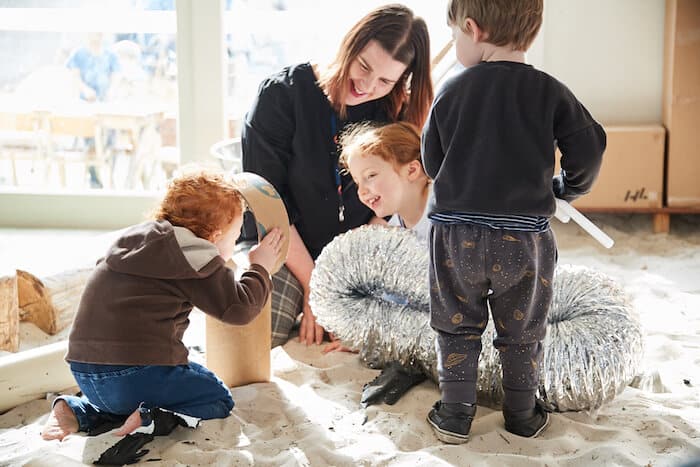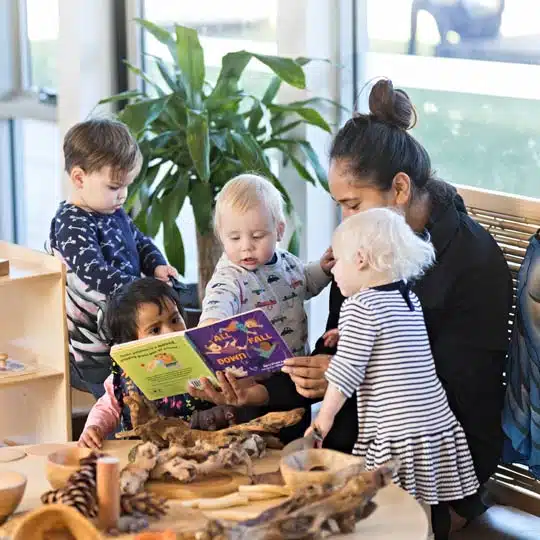Sandpit Play

At Guardian, our spacious outdoor environments provide yet another sensory-rich space for children to learn, explore, and discover.
Many of our centres include natural play areas that allow for climbing, engaging, and creating—each with exciting features for children at any developmental stage. Things like river beds, a water pump, and large undercover sandpits are all examples of features we purposefully create at each of our childcare centres so that we can inspire children to learn through play.
And while these intentionally-designed outdoor spaces certainly encourage the children in our centres to exercise and exert themselves in the fresh air—which are both very important to their health and well-being—they also help them connect with nature. Plus, they support each child in drawing connections to the importance of sustainable practices and taking care of our environment.
To help you learn more about the benefits of outdoor play—particularly sandpit play—and how Guardian provides plenty of outdoor play opportunities at each of our childcare centres, we’ve put together this helpful guide.

What is Sandpit Activity
Sandpit activity is any type of play that children engage in while using sand as an artistic medium. With sandpit play, children can do things like dig, scoop, pour, or push sand as well as lift, rake, pat, or shape it.
When given a variety of sand play materials, the options for creating with sand become endless. And there are plenty of sand play materials that children enjoy playing with at our centres such as:
- Fingers and toes
- Buckets
- Dump trucks
- Wheelbarrows
- Rakes
- Spades
- Measuring cups
- Jugs
- Teapots
- Sieves
- Funnels
- Moulds
Plus, there are all kinds of objects around our centres that make a great addition to sandpit play, providing new sand play materials the children will love. Anything from woodblocks in our classrooms to shells and cardboard tubes can instantly become a new and fascinating sand play material for the children to play with.
And the sand play areas at Guardian centres are built intentionally large so that children have plenty of space to create their own sandpit masterpieces—anything from castles to moats, driveways to highways, trenches to holes, and houses to towers. At Guardian, each child’s own creativity guides them.
So when can kids use the sandpit? Well, the good news is that children can start playing with sand at a pretty early age. With the supervision and support given by our amazing team members at Guardian, children can let their imaginations soar and use sand as an artistic medium to express themselves while they’re here during the day.
At Guardian, we don’t have an established sand play activity plan developed for all children. Instead, we place each child at the centre of their own learning journey, providing them with high-quality resources to learn through play and create meaning on their own.
After all, research shows that children learn best through hands-on exploration. So, the sand play activities for preschoolers you’ll see taking place at many of our centres can be anything from building and smashing to looking closely at the grains of sand and feeling their texture.
At Guardian, we don’t tell kids what to learn nor do we place limits on their ability to learn and that includes the learning that is taking place in our sandpits. Here, children have endless opportunities to think, explore, and grow—helping them develop skills that easily translate from the sandpit into a lifetime of learning.
Why is Sandpit Play Important
There are so many reasons why sandpit play is important for children. Sandboxes are good for kids because they’re just plain fun, but they also provide learning opportunities children just can’t get anywhere else. Plus, sandpit actually helps them reach those 21st-century learning outcomes that will follow them throughout their lifetime.
What do children learn when they play with sand? Plenty of things!
First, sand is a very textured medium, and it feels noticeably different against a child’s skin when they cup it in their hand, dig through it, or even rub it between their fingers. From burying their toes in the sand to pouring a bucket of water over it, children are thinking and reaching conclusions through each hands-on sand activity they participate in. And those conclusions inspire them to think deeply about other everyday items they encounter each day.
That’s why sandpit play is such an important part of sensory play. Children learn a lot more about the properties of sand by smoothing it, scooping it, patting it, and moulding it themselves than they would ever learn from just hearing or reading about it alone. Just think about the critical thinking that takes place as children experiment with the structural properties of wet sand versus dry sand and how wet sand is easier to mould into shapes while dry sand is easier to pour from a bucket.
Plus, sand play helps children build fine motor skills and hand-eye coordination as they use various tools in order to manipulate the sand. Activities like using a stick to draw their name in the sand or using a digger to move sand around from one area of the sandbox to another both require a lot of fine motor skills and hand-eye coordination that young children are still developing.
Sand play helps with emotional development and socialization in children as well. In the sandpit, kids learn collaboration skills as they dig, carry, and move sand with other children and educators. They learn to wait patiently and take turns with the sand play materials we have on hand. And they develop team-building skills as each child becomes responsible for completing certain tasks within the sandbox.
Furthermore, sandpit play helps children develop physically as well.
As children play in the sand, they build both their small muscles—like their triceps, biceps, and calves—as well as their large muscles like those in their legs, back, and chest. A shovel or bucket full of sand is heavy to carry for young children and pushing a rake through sand creates a lot of resistance as well. So, both of these activities, and others like it, ensure that your child is using different muscle groups and getting stronger every day.
Lastly, sandpit play helps children build communication skills as they share their ideas for sand play with others and complete mark-making activities in the sand by drawing shapes, numbers, and letters. Communication is an important skill to develop and playing in the sand can actually help them get there.
The wonderful thing about the experiences children have at each of our centres is that their learning outcomes overlap, and they vary depending on the child, educator, and each particular experience they encounter.
So, whether your child is playing in the sandpit or using the water pump, they’re developing important skills that will carry over into other areas in their life and will benefit them long into their formal education and adulthood.
At Guardian, we understand just how important play-based learning is to the development of a child. So, we are passionate about creating sensory-rich indoor and outdoor spaces that inspire children to be creative, brave, and curious about the world around them.
And the outdoor covered sandpits we have at many of our childcare centres throughout Australia are just one of the many ways we provide high-quality resources to help your child think and grow.
Note: While we have listed some outcomes, the wonderful thing about experiences at our centres is that learning outcomes overlap and vary depending on the child, educator and particular experience.
What Learning Looks Like
at Different Ages
Looking for the right Childcare Centre for your Family?
Submit your details and a member of our Concierge Team will be in touch to discuss what you need and how we can help you experience something more than childcare.
We'll be in touch soon.



